Workaholism Facts and Statistics (2025)

Research indicates that workaholism affects between 27% and 30% of the general population today. In popular culture, “workaholism” is a buzzword often used to describe devotion to work in a positive light — by defining themselves as workaholics, people often think they are showcasing their passion for their jobs.
However, we shouldn’t equate work addiction with:
- Having a great work ethic,
- Being dedicated to your work,
- Loving your job, or
- Working long hours to beat a deadline from time to time.
Workaholism, or work addiction, is a serious problem that can lead to career burnout. In the most extreme cases, severe overworking can result in serious health issues — even death.
How do you discern between healthy and unhealthy work habits? We’ll explore relevant workaholism-related research, facts, and statistics to answer the question in detail.
What is workaholism?

The term “workaholic” was coined in 1971 by American psychologist Wayne E. Oates in his book Confessions of a Workaholic: The Facts About Work Addiction.
He defined it as “the compulsion or the uncontrollable need to work incessantly.”
Over the years, various authors have offered slightly different interpretations, which we’ll explore later. But first, let’s consider what defines a workaholic.
What is a workaholic?
A workaholic is someone who works compulsively or is addicted to work. However, there is no universally agreed-upon definition, and empirical research on workaholism is still limited.
Even without a firm consensus, many researchers have worked to clarify the term. According to Scott, Moore, & Miceli (1997), workaholics exhibit 3 key characteristics:
- They spend a lot of time on work activities,
- They are preoccupied with work, even outside working hours, and
- They work beyond what is expected or required to finish their tasks.
Since Oates introduced the concept of workaholism, other researchers have proposed different definitions, including:
- Addiction to work (Robinson, 2000; Porter, 2006; Ng, Sorensen & Feldman, 2007),
- A pathological condition (Fassel, 1990),
- A behavior pattern that persists across multiple work environments (Scott, Moore & Miceli, 1997), and
- A syndrome characterized by high drive, high work involvement, and low work enjoyment (Aziz & Zickar, 2006).
In recent years, the “addiction model” has gained a lot of traction — comparing workaholism to behavioral addiction, similar to gambling or substance abuse.
According to another model by Taris et al. (2008), workaholism consists of 2 main components:
- The behavioral component — characterized by working excessively hard, often leading to long work hours, and
- The psychological component — characterized by an obsession with work and an inability to detach yourself from it.
More recent research by Aziz & Covington (2024) addresses both models. It acknowledges the different aspects of workaholism without equating it with an addiction.
According to this model, we should differentiate between:
- Workaholism — a need to work too hard, driven by internal pressures instead of external demands or financial incentives,
- Work addiction — a medical condition viewed as an aspect of compulsive behavior, and
- Work engagement — a healthy, fulfilling state where you enjoy work but can still detach from it.
What causes workaholism?
Researchers use different methods to define and classify the causes of workaholism. However, we can group most causes into one of the following categories:
- Emotional causes — workaholics feel guilty and anxious when they aren't working,
- Behavioral causes — workaholics often feel reinforced by financial rewards and increased status,
- Motivational causes — workaholics often believe that working compulsively will improve their self-esteem, help them earn more, or increase their social status,
- Childhood causes — workaholics might have had overly protective or overly demanding parents, and
- Genetical causes — workaholics may have deeply ingrained traits such as perfectionism.
Exhibiting any of these 5 traits doesn’t necessarily make you a workaholic. So, how do you determine if someone is a workaholic or not?
Workaholics meaning: What workaholism is NOT
You might believe you’re a workaholic.
However, you may simply be a hard worker who occasionally puts in long hours. There’s a difference between workaholism and having a strong work ethic or high work engagement.
Here’s what sets them apart.
Being a workaholic vs. working hard
According to a Harvard Business Review article, not everyone who works hard is a workaholic.
Rather, you may show signs of workaholism if you keep thinking about work outside of office hours, and other aspects of your life suffer.
You’re only a workaholic if you can't detach from your job. On the other hand, staying focused at work and working late isn’t necessarily worrisome.
True workaholics work hard because they need to feel busy. Unless they constantly worry about work, they feel guilty and insecure.
According to psychologists, this insecurity stems from the workaholics themselves. In a nutshell, they don’t understand how much the organization they work for values them.
So, workaholics try to compensate for a perceived lack of value and importance by being busy. To them, the busier they are, the more important they must be.
Non-workaholics stop working hard once they achieve their goals.
But for workaholics, enough is never truly enough. They never feel they’ve truly succeeded. In other words, they never feel the sense of accomplishment that comes with objective success.
🎓 How to overcome imposter syndrome at work
Being a workaholic vs. having a strong work ethic
Having a strong work ethic means demonstrating certain values in your conduct at work, including:
- Punctuality,
- Focus on work,
- Dedication,
- Professionalism,
- Continuous improvement,
- Taking initiative, and
- Being productive.
None of these qualities necessarily make you a workaholic. In fact, you can uphold all of them without jeopardizing your work-life balance.
Being a workaholic vs. working long hours
Workaholics tend to work long hours. However, working long hours doesn't necessarily mean you’re a workaholic. According to an article in the Harvard Business Review, the difference lies in your ability to switch off after work.
You can work 60+ hours per week without being a workaholic — if you can stop worrying about work after you clock out.
On the other hand, someone might work a little over 40 hours per week and be a workaholic if they keep obsessing over work at home.
You can also recognize workaholism by the effects it produces. Some research suggests that workaholic tendencies may lead to diabetes and heart disease.
Similarly, workaholics report sleep problems and emotional exhaustion more often than those who simply work long hours.
Being a workaholic vs. having high work engagement
Some people may appear to be workaholics simply because they love their jobs.
However, there’s a difference between people who constantly worry about work and those who think about their job because they enjoy it — especially health-wise.
Research by Afota, Robert, & Vandenberghe (2025) shows that workaholism and work engagement involve different types of work investment.
As a result, workaholism and work investment affect employee health and job performance differently:
- Work engagement — associated with lower emotional exhaustion and reduced risk of depression over time, and
- Workaholism — linked to increased emotional and physical exhaustion and higher risk of depression.
In another study conducted on a group of engineers, researchers found that workaholics had a more severe history of depression than non-workaholics.
Other research (Stefano & Gaudiini, 2019) also indicates a clear difference between workaholism and work engagement. The study describes workaholism as a “pathology” and work engagement as a “healthy form of heavy work investment.”
How to recognize workaholic's characters

To help you recognize true workaholism, we’ll examine the signs, symptoms, and behaviors of different types of workaholics.
What are the signs of workaholism?
A 2019 study published in the New York Post polled 2,000 employed Americans. Here are the 10 telling signs of a workaholic:
- In 54% of cases, workaholics prioritize work before their personal lives.
- In 51% of cases, they worry about work, even on a day off.
- In 50% of cases, they struggle to switch off while on vacation or simply work throughout their vacations.
- In 48% of cases, they check emails even at night.
- In 46% of cases, they are the first to arrive at work and the last to leave. Moreover, the same share of respondents feel too pressured or busy to take annual leave.
- In 45% of cases, they skip their lunch breaks, while the same share feel anxious if they don't know what's going on at work.
- In 44% of cases, friends or family members tell them they work too much.
- In 39% of cases, they check emails first thing in the morning.
According to a 2024 Forbes survey of 19 experts, we can also recognize workaholics by the following behaviors:
- Overworking without focus,
- Using work to avoid negative feelings,
- Working inefficiently but with a lot of motivation,
- Ignoring signs of burnout,
- Lacking self-awareness,
- Measuring achievements by effort instead of results, and
- Not seeing the big picture.
🎓 How to recognize if you’re being overworked | Should I work overtime without pay?
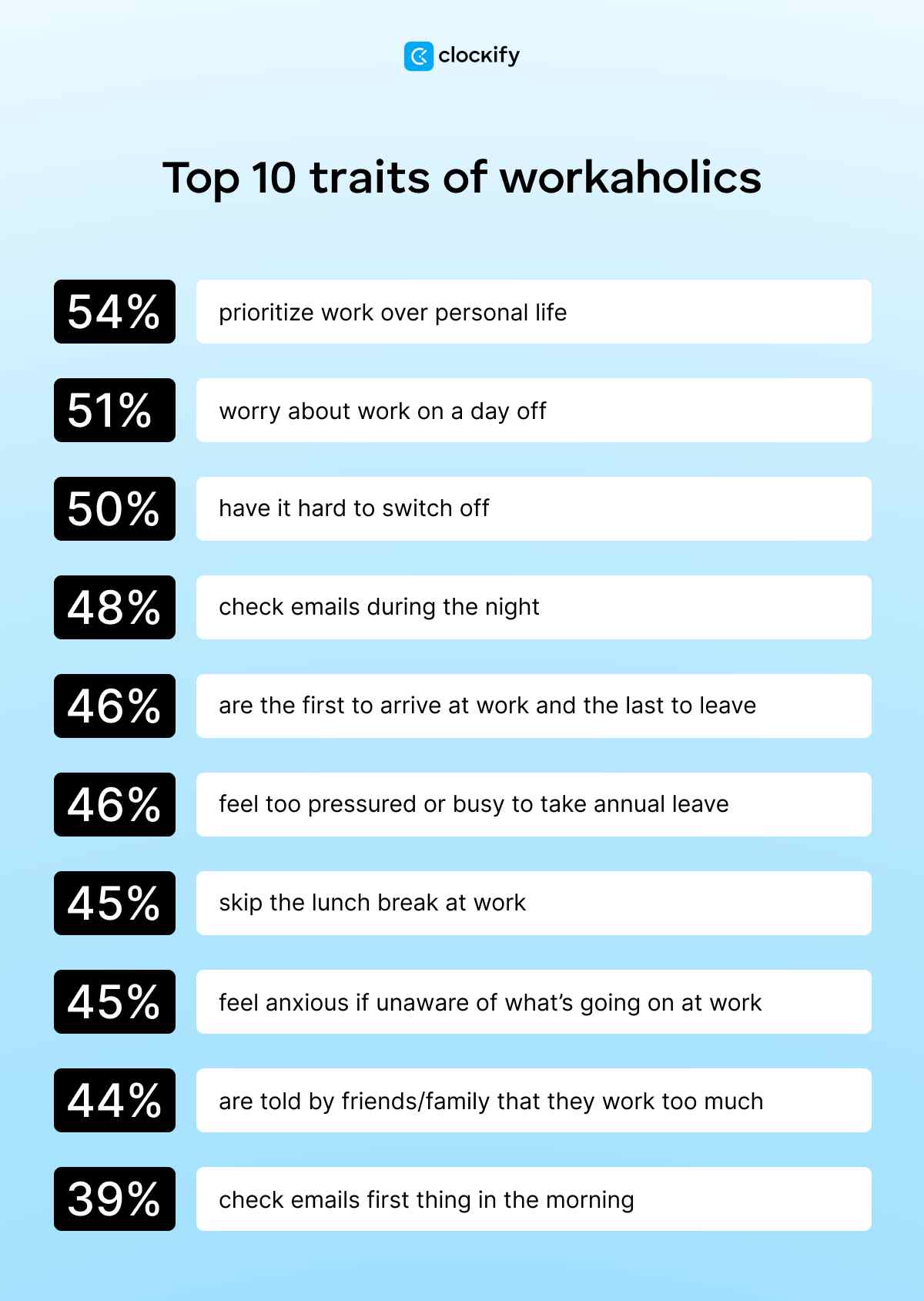
What are symptoms of workaholism?
Norwegian researchers from the University of Bergen have developed a self-assessment tool to measure work addiction — the Bergen Work Addiction Scale.
The scale can help you determine if someone is a workaholic. To develop the tool, the Bergen researchers studied 16,426 working adults in Norway based on 6 main symptoms:
- Salience — the phenomenon of being preoccupied with work,
- Mood modification — the phenomenon of using work to alleviate emotional stress,
- Tolerance — the ability to gradually work longer hours over a continued period with the same mood-modifying effects,
- Withdrawal — the feeling of physical and emotional distress if unable to work,
- Conflict — the phenomenon of sacrificing relationships and social obligations because of work, and
- Relapse — the phenomenon of suffering negative consequences of excessive work.
The Bergen Work Addiction scale consists of 7 declarative sentences you can answer with:
- Never,
- Rarely,
- Sometimes,
- Often, and
- Always.
The final tally of the answers helps you determine whether you are a workaholic. And here are the statements:
- You think of how you can free up more time to work.
- You spend much more time working than you initially intended.
- You work to reduce feelings of guilt, anxiety, helplessness, and depression.
- You have been told by others to cut down on work without listening to them.
- You become stressed if you can’t work.
- You prioritize work over hobbies, leisure activities, and exercise.
- Your excessive work has negatively influenced your health.
If you’ve answered “often” or “always” to at least 4 of the 7 statements, you have a work addiction.
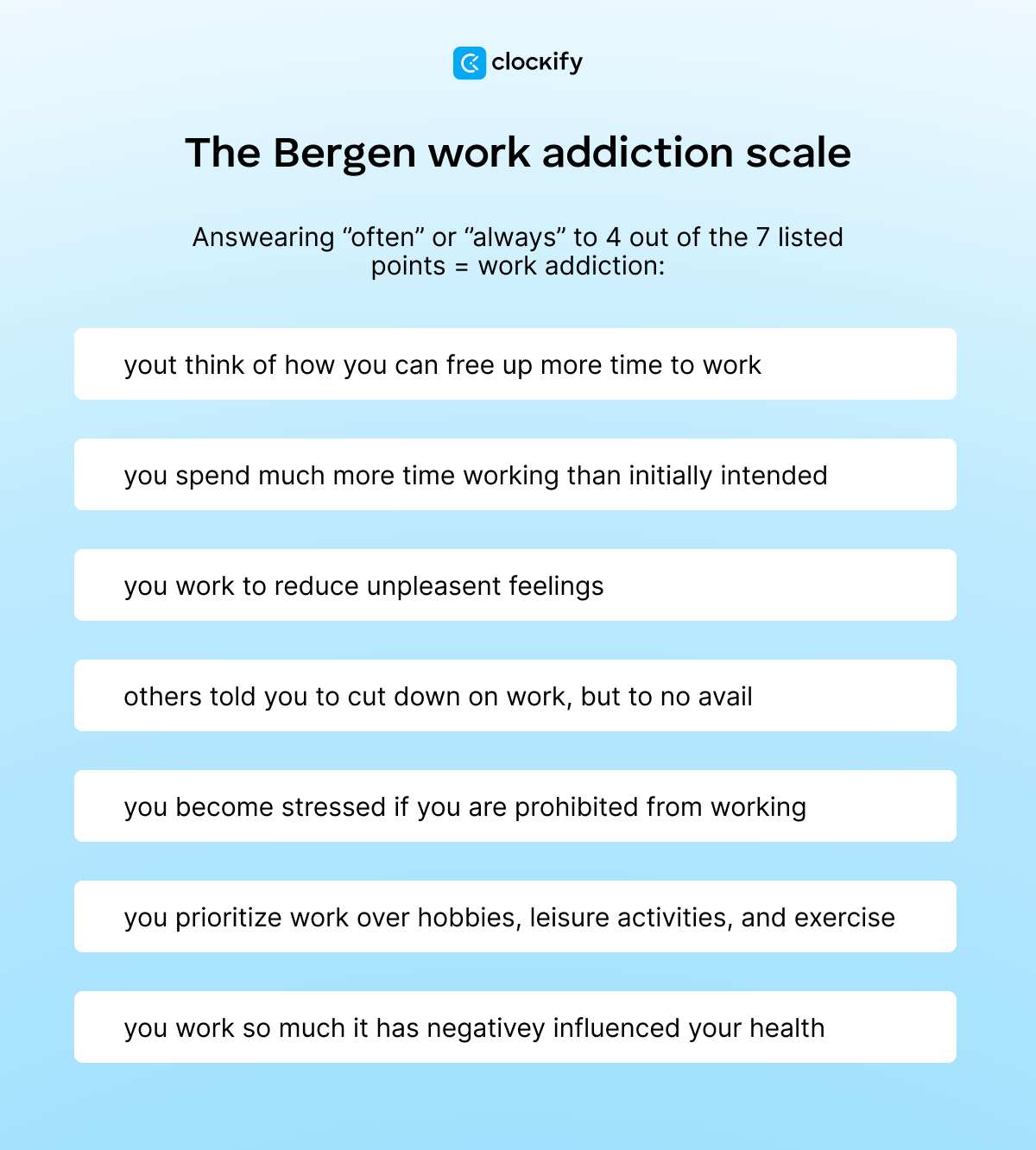
What do workaholics sacrifice for work?
Another way to recognize workaholism is to consider what you are willing to sacrifice for work.
One USA Today poll covering the period between 1987 and 2008 has identified what people sacrifice for the feeling of “busyness” at work, to which most workaholics are addicted.
Basically, most workaholics sacrifice:
- Sleep (56%),
- Recreation (52%),
- Hobbies (51%),
- Time with friends (44%), and
- Family time (30%).
Most worryingly, these sacrifices can lead to more serious mental issues.

The correlation between workaholism and psychological disorders
According to the same study that spawned the Bergen Work Addiction scale, there is a link between workaholism and psychological disorders.
These disorders include anxiety, ADHD, OCD, and even depression. Here are the main findings:
- More workaholics suffer from anxiety than non-workaholics (33.8% vs. 11.9%),
- More workaholics suffer from ADHD than non-workaholics (32.7% vs. 12.7%),
- More workaholics suffer from OCD criteria than non-workaholics (25.6% vs. 8.7%), and
- More workaholics suffer from depression criteria than non-workaholics (8.9% vs. 2.6%).
Note that the study only establishes a correlation between workaholism and psychological disorders — not causality.
In other words, the research doesn’t indicate that psychological disorders cause workaholism or vice versa.
The correlation between workaholism and personality traits
Over the years, various researchers have examined the link between workaholic tendencies and certain personality traits.
The Big Five personality traits test (also known as the 5-factor model and the OCEAN model) grades people on their:
- Openness to experience,
- Conscientiousness,
- Extraversion,
- Agreeableness, and
- Neuroticism.
According to Harb, Sarhan, & Ensour (2023), some personality traits may be associated with workaholism. These include:
- Conscientiousness — extremely diligent employees often struggle with work-life balance,
- Neuroticism — people suffering from emotional instability and anxiety are more likely to overwork, and
- Narcissism — individuals with self-image issues often seek validation through excessive work.
Studies have also shown that people with personality type A (ambitious, status-conscious, impatient, anxious, and rigid) are more likely to exhibit hostility, time urgency, and competitiveness.
Previous research has linked these behaviors with workaholism.
🎓 Productivity tips for 16 personality types based on MBTI
What are the types of workaholics?
Since the term “workaholism” was first introduced in 1971, researchers have defined several types of workaholics.
As there’s no universally accepted definition of a workaholic, these categories sometimes overlap. Let’s explore them in more detail.
Definitions of workaholic types in the 1970s
First, Oates (1971) recognizes 4 types of workaholics:
- Dyed-in-the-wool workaholics are perfectionists who take work seriously and only aim for the highest performance standards,
- Converted workaholics set limits to their work hours and aim to have and enjoy free time,
- Situational workaholics don’t have a typical workaholic personality but aim to achieve high standards in certain situations, and
- Pseudo or escapist workaholics mimic the behavior of workaholics to gain or maintain a high position at work. Or, they use work to escape their unhappy home life.
Definitions of workaholic types in the 1980s
According to Rohrlich (1981), we can differentiate between 4 main types of workaholics, depending on their work style and compulsive characteristics:
- Escapist workaholic — uses work to avoid personal issues or emotional distress,
- Obsessive work addicted — feels an overwhelming compulsion to work, sometimes to the point of endangering relationships and personal well-being,
- Competitive work addicted — overworks to achieve recognition and status by outperforming others, and
- Defensive work addicted — works excessively to counter feelings of self-doubt, anxiety, and inadequacy.
Next, Naughton (1987) recognizes 2 types of workaholics:
- Job-involved workaholics — they are high in work commitment and low in work compulsion, and
- Compulsive workaholics — they are high in both work commitment and compulsion.
Definitions of workaholic types in the 1990s
Fassel (1990) recognizes 4 types of workaholics:
- Compulsive workers are driven to work all the time. They represent the universal stereotypical view of workaholics often depicted in the media,
- Binge workers work in binges rather than continuously,
- Closet workers hide work so they won't be discovered working when they're not supposed to, and
- Work anorexics avoid work through procrastination and then experience an adrenaline rush upon finishing a project at the last minute.
Scott, Moore, & Miceli (1997) recognize 3 types of workaholics:
- Compulsive-dependent workaholics who exhibit symptoms of the obsessive-compulsive personality,
- Perfectionist workaholics are preoccupied with rules and details. They pursue work and productivity at the cost of social activities and leisure time, and
- Achievement-oriented workaholics who strive toward success and achievement in moderately difficult tasks.
Definitions of workaholic types in the 2000s
Robinson (2000) recognizes 4 types of workaholics:
- Relentless workaholics — they aim to work all the time and believe work is more important than anything else in life, similar to Oates's dyed-in-the-wool workaholics,
- Procrastinating workaholics — they procrastinate until the last minute and then work frantically to finish a task,
- High stimulus-seeking workaholics — they are easily bored and seek excitement through tight work schedules with multiple (preferably new) parallel projects, and
- Bureaupathic workaholics — they tend to prolong tasks and create additional work.
🎓 Dealing with procrastination: Why it happens and how to fix it
Definitions of workaholic types in the 2010s
First, Glicken (2010) recognizes 6 types of workaholics:
- Loner workaholics work hard and want to be left alone while doing so,
- Frightened workaholics are afraid of losing their jobs. Thus, they constantly worry about not completing tasks on time or with the expected quality,
- Burned-out workaholics continue their work, even without job satisfaction, due to a lack of other interests,
- Incompetent workaholics work hard. However, they can’t get much done due to incompetence,
- Dictatorial workaholics push others to work harder than necessary rather than taking on this habit themselves, and
- Manic-depressive workaholics may work hard and achieve incredible results during their manic highs. But then, they slump to inactivity during their manic lows.
Second, Robinson (2013) suggested another categorization after his initial one from 2000, where he recognizes 4 types of workaholics:
- Relentless workaholics are the same type as the one he suggested in his previous work,
- Bulimic workaholics aim to perform their work perfectly or not do it at all,
- Savoring workaholics are consumed by their attention to detail, and
- Attention-deficit workaholics start multiple projects but get bored and move on to new challenges.
The effects of workaholism

Now you know how researchers define workaholism and how to recognize the signs of workaholism in real life.
For the next step, we explore the harmful effects of workaholism on the workaholic — and others around them.
The effects of workaholism on work, family, and individual outcomes
The impact of workaholism on personal and family life was first studied by Bryan E. Robinson, a psychotherapist and professor at the University of North Carolina.
In his latest book, Chained to the Desk in a Hybrid World, he presents the following conclusions regarding the effects of workaholism.
The effect on work outcomes:
- Lower productivity — due to the inability to delegate tasks,
- No impact on work performance — due to overworking being canceled out by inefficiency, and
- Career stagnation — due to lower productivity, high stress, and middling performance.
The effect on family outcomes:
- High marital dissatisfaction — due to emotional withdrawal and estrangement,
- Lack of communication — due to lower interest in family members’ concerns and emotions, and
- More childhood issues — due to children of workaholics experiencing higher rates of depression and anxiety.
The effect on individual outcomes:
- More chronic stress — due to being constantly consumed by work,
- Higher risk of burnout — due to higher stress and anxiety levels, and
- Poorer physical health — due to elevated cholesterol levels, lower cognitive efficiency, and poor sleep quality.
As the data shows, workaholism significantly reduces the quality of personal and family life. On the other hand, it doesn’t meaningfully improve career prospects.
🎓 Career burnout and its effect on health

Effects of workaholism on health and eating habits
Multiple studies confirm that workaholic tendencies can strongly affect your health and eating habits.
Let us look at a study by Chan, Ngan, & Wong (2019) covering the period between 1998 and 2018. The study suggests that people who work 11 hours per day (such as workaholics) have a 67% bigger chance of suffering from coronary disease than people who work 8 hours per day.
According to the Scandinavian Journal of Work Environment and Health, excessive work (over 55 hours per week) is linked to an increased risk of accidents and injuries.
Similarly, a study by Balducci, Avanzi & Fraccaroli (2018) points to a link between workaholism and health problems, including high systolic blood pressure and mental distress.
The modern workaholic culture is also changing our eating habits — like how people eat lunch.
ezCater, a corporate catering firm, surveyed 5,000 workers in 10 major U.S. cities to learn about the lunch habits of modern employees. Here are their results:
- 49% of respondents skip lunch at least once per week,
- 62% of respondents eat lunch at their desks, and
- 23% of respondents fear they won’t have enough time to get their work done if they take a lunch break.
🎓 10 Productivity exercises for body and mind
Workaholic relationship problems
Workaholic tendencies can negatively affect the spouse and children of the workaholic.
According to Professor Bryan E. Robinson, marriages with at least one workaholic have a 40% higher divorce rate.
Another study on children’s outcomes in a family of workaholics found that workaholism increases children’s emotional and behavioral problems. On the other hand, work engagement by parents positively impacted children’s happiness.
Also, one study of 537 participants in Lithuania found that the perceived work addiction of the father and mother was related to increased work addiction in their adult child. Interestingly, the father’s work behaviors had a higher impact on the child.
Workaholism by industry
Employees in some sectors are more likely to become workaholics for different reasons. In some industries, employers commonly expect employees to work overtime. In others, employees are driven to overwork by financial and other incentives.
According to the U.S. Bureau of Labor Statistics, these were the average weekly hours across different industries in February 2025:
| Sector | Average hours worked per week |
|---|---|
| Mining and logging | 43.8 |
| Construction | 38.6 |
| Manufacturing | 40.1 |
| Wholesale trade | 39.2 |
| Retail trade | 29.6 |
| Transportation logistics | 38.1 |
| Utilities | 42.1 |
| Information | 37.0 |
| Financial activities | 37.6 |
| Hospitality and leisure | 25.4 |
| Private education and health services | 32.8 |
| Business services | 36.2 |
| Other services | 31.9 |
Workaholism in IT
A Romanian study on workaholism in IT found that many self-identified “workaholics” in the industry work hard due to an intrinsic pleasure of working.
While this is positive work engagement that most research wouldn’t classify as workaholism, the same study found that IT professionals also overwork due to:
- A sense of responsibility towards family,
- Desire for professional improvement, and
- Financial incentives.
Workaholism in finance
A study on workaholism in finance concluded that burnout was the most likely outcome of workaholism. It also found that workaholism had a severe negative impact on employees’ health, including symptoms like:
- Sleep disturbances,
- Headaches,
- Extreme tiredness, and
- Back pain.
These symptoms demonstrated that the adverse effects of workaholism weren’t just psychological but also physical.
Workaholism in academia
A 2023 Montenegrin study on workaholism in academia also found that burnout was the most likely result of excessive work.
Interestingly, the authors concluded that work engagement and workaholism had one common denominator among the study participants — high work dedication.
To reduce burnout among academia employees, the researchers suggest interventions that enhance work dedication without promoting overwork as a habit.
Workaholism around the world
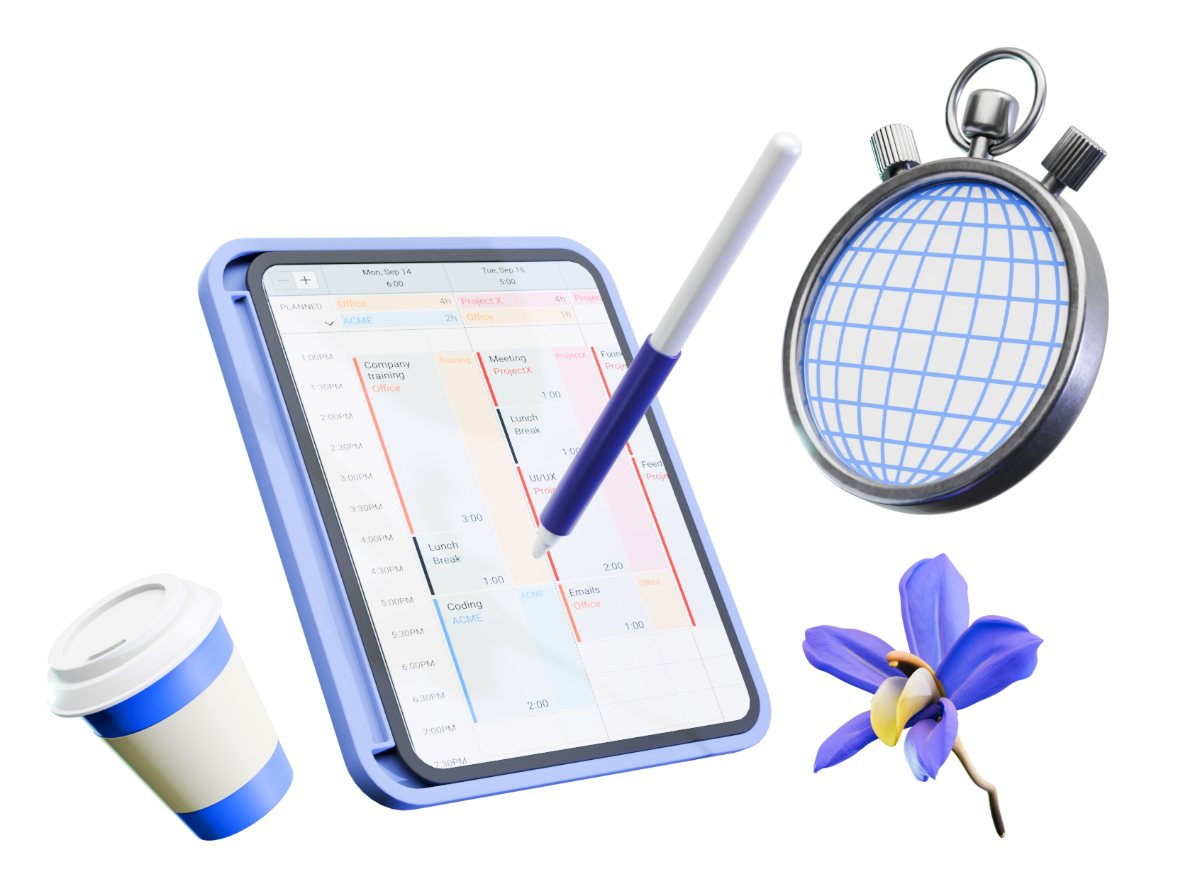
Workers in developed countries experience the effects of workaholism to varying degrees.
Still, from Japan and Norway to the United States, many workers have to deal with workaholic tendencies.
In the next section, we will dissect the main findings of studies on workaholism in some of the world’s most affluent nations.
Workaholism in the UK
According to the Guardian, around 1 in 4 employees in the UK suffer from workaholism.
This is no surprise, as a 2024 study by a leading UK recruitment firm found that:
- 70% of employees find it difficult to switch off from work,
- 76% of employees check messages outside of work hours, and
- 35% of employees feel work-related stress and anxiety.
The study has shown that the ability to check work notifications and emails from mobile devices has led to a diminished work-life balance.
🎓 Personal productivity guide: Maximize productivity with these methods and apps
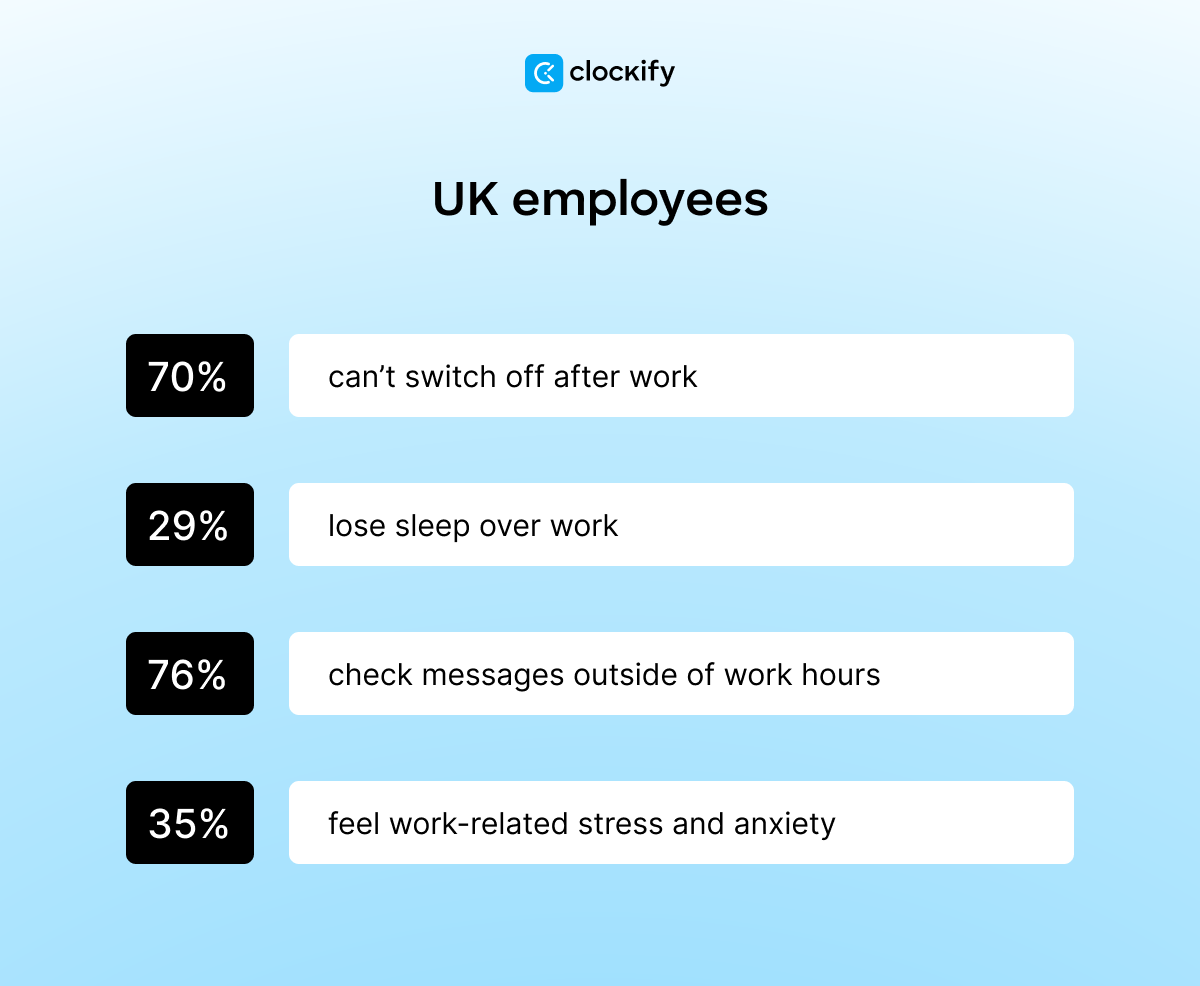
Workaholism in Germany
A representative study in Germany examined 8,000 employees across all sectors in search of workaholic behavior. The Institute of the German Federation of Trade Unions commissioned the research through its Hans Böckler Foundation.
The main findings suggest that 33% of the German workforce overworked during the study, while 9.8% exhibited compulsive behavior. On the positive side, as many as 54.9% of employees said they approached their work tasks relaxed.
Women were overall more likely to be workaholics than men. At the same time, researchers said that youth aged 15 to 24 were far more likely to suffer from workaholism than older workers aged 55 to 64.
Finally, the same study found that self-employed people have a far greater risk of becoming addicted to work. Considering that there are almost 3.8 million self-employed workers in the country, this is an alarming figure.
Workaholism in the United States
According to the economics department at Washington University in St. Louis, many positive changes are underway.
As stated in their study on workaholic tendencies, the top-earning 10% of the male population in the US labor market clocked 77 fewer work hours in 2022 than in 2019. Similarly, female employees cut back time at work by 29 hours for the same period.
Interestingly, one of the co-authors, Yongseok Shin, told The Wall Street Journal that many workaholics are “pulling back, often by choice.”
So, are Americans overworked?
Well, according to the previously mentioned article in the New York Post, workaholism is a self-identified trait of many modern-day Americans.
This article also shows that 48% of Americans consider themselves to be workaholics. However, only 28% of them claim they work so hard because of financial necessity. Moreover, an average American works 4 hours per week for free and spends an additional 4 hours per week just thinking about work.
However, a paper by Griffiths, Lisha, and Sussman (2011) indicates that only about 10% of American workers have a true addiction to work. This gives rise to the theory that people may be confused about what workaholism really is.
Still, there’s no denying that American workers, especially younger generations, think they work too much. According to the American Psychological Association’s 2024 survey, 45% of workers between 18 and 25 report feeling overworked.

Workaholism in Norway
In 2014, one nationwide survey in Norway showed that workaholism was identified among 8.3% of employers and employees. Here is a rundown of the most striking findings of that research:
- Women were somewhat more susceptible to workaholism than men (51% vs. 49%).
- The age group with the largest prevalence of workaholism was 46-58 years old (36.5%).
- Workers living with a partner were much more susceptible to workaholism than workers not living with a partner (82.5% vs. 17.5%).
- Employees without childcare responsibilities were somewhat more susceptible to workaholism than workers with childcare responsibilities (57% vs. 43%).
- Workers with a 100% full-time equivalent were much more susceptible to workaholism than workers with a lower full-time equivalent (78.3% vs. 21.7%).
- People with vocational school education were most likely to be workaholics (33.7%).
Yet, a more recent study from 2019 painted a slightly better picture, with the prevalence of workaholism being 7.3%. However, it all depends on the particular industry, work environment, and work setting.
🎓 What is full-time equivalent and how to calculate it (+ free FTE calculators)

Workaholism in Japan
Japan is famous for its work ethic but also notorious for its workaholic tendencies.
As a result, Karoshi, or "death by overwork," is a common occurrence in Japan. It is tied to:
- Heart attacks,
- Strokes,
- Starvation diets, and
- Suicides.
The threat of Karoshi is so prevalent that the Japanese government accepts some 200 workplace injury claims for Karoshi every year. A government white paper on the issue suggests that 2,968 suicides were related to overwork in 2022 alone.
Yet, anti-Karoshi campaigners declare that there are around 10,000 deaths caused by this modern-day disease annually. Also, one study has found that as many as 63% of Japanese employees feel guilty about taking annual leave.
Some initiatives to combat this issue include assigning ”embarrassment” capes for overtime workers. Another campaign to the same effect was canceled in 2023 due to ineffectiveness — optional Premium Fridays (the permission to leave at 3 p.m. on the last Friday of the month).
Sadly, the abolishment of the workaholic culture in Japan still has a long way to go.
🎓 How to deal with toxic productivity | How to manage efficiently working 80+ hours a week
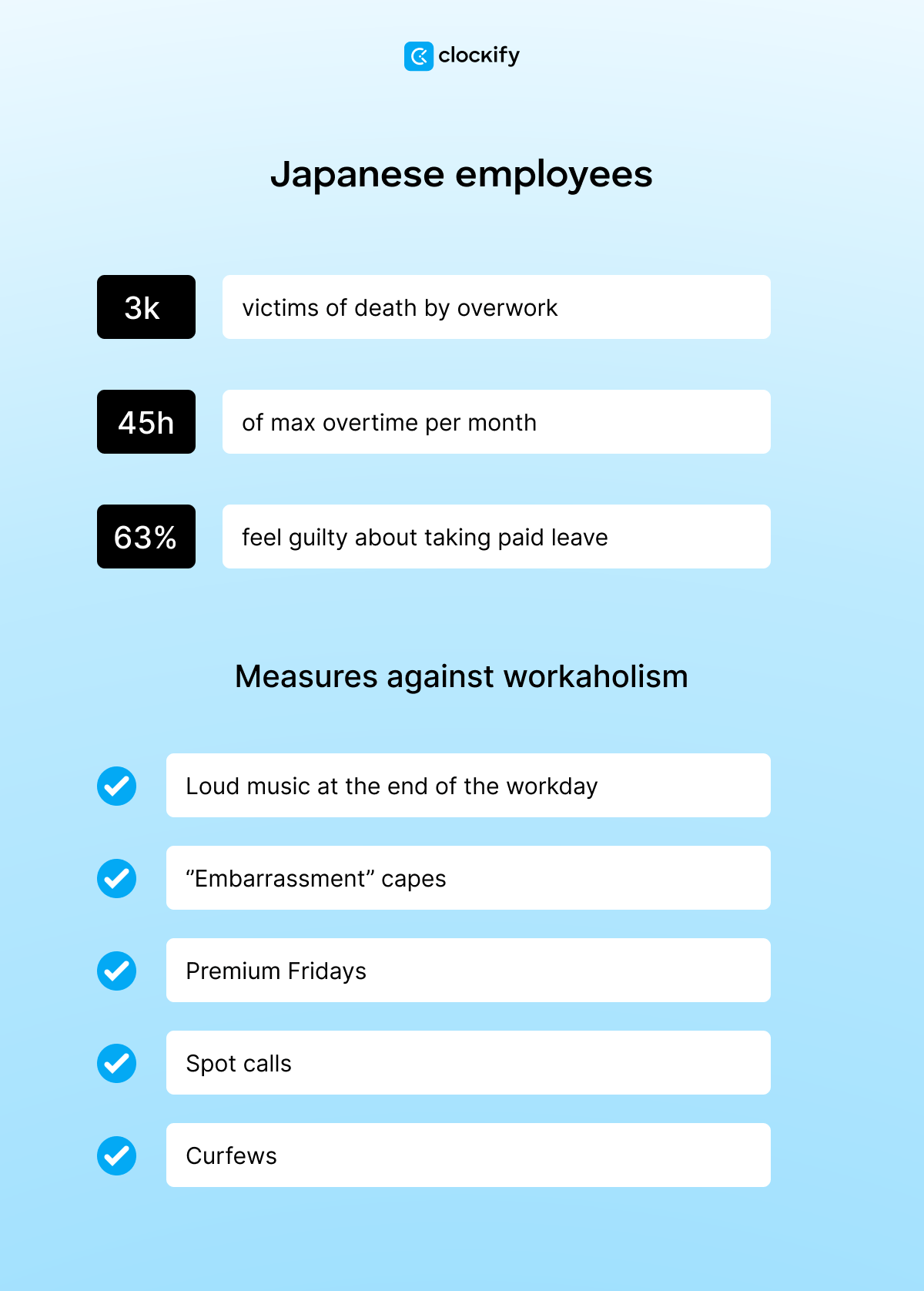
Countries with the highest share of people working long hours
While people who work long hours are not necessarily workaholics, people who are workaholics tend to work long hours.
The latest Organization for Economic Co-operation and Development (OECD) data highlights the 5 countries where people work the longest hours per year. These are countries where people have a higher chance of developing workaholism. Here’s the list with data from 2024:
- Colombia — 2,298 hours,
- Turkey — 2,283 hours,
- Mexico — 2,272 hours,
- Costa Rica — 2,210 hours, and
- Chile — 2,101.
Note that this list of the most overworked countries changes almost every year.
Global workaholism vs. hourly productivity
So, why do workaholics tend to work longer hours?
Sometimes, it is actually because they (or their organizations) think it makes them more productive.
Yet, data from the International Labour Organization indicates that the number of hours worked is not linked to productivity, at least not in terms of GDP per hour worked.
| Country | GDP per hour worked | Average hours worked / week |
|---|---|---|
| Luxembourg | $166.1 | 35.6 |
| Ireland | $139.1 | 35.6 |
| Norway | $123.6 | 33.7 |
| Guyana | $113.9 | 44.7 |
| Denmark | $97.0 | 33.9 |
| Singapore | $96.9 | 42.6 |
| Belgium | $91.6 | 35.0 |
| Netherlands | $90.4 | 31.6 |
| Austria | $90.1 | 33.3 |
| Sweden | $85.7 | 35.3 |
Coincidently, none of the top 10 countries with the highest GDP per hour worked can be found in the list of the top 10 countries with the highest average hours worked per week.
This means that long working hours don’t translate into higher GDP or higher income. Employees in wealthier countries work fewer hours while earning much more than their counterparts in low-income and middle-income countries.
The link between work environment and long hours in Colombia
Although Colombia has one of the highest numbers of hours worked per week (44.2), it also has the lowest GDP per hour worked ($18.9).
For illustration, the Miami-based newspaper Infobae cites a literature review on work dynamics in Colombia. One of the findings is that 85% of employees believe that problems at work negatively impact their relationships with children, spouses, or other family members.
The same research suggests that work stress, fatigue, and anxiety are among the major culprits contributing to a toxic work environment. To that effect, 62% of workers in companies and organizations stated they suffered from some of these physical and mental health issues.
Colombian employees working long hours are also less likely to be productive overall. In fact, stress-induced health issues and other problems with workaholic tendencies are more likely to reduce productivity over time rather than help increase it.
🎓 25 ways to increase productivity
Global workaholism and vacations
Workaholic tendencies include working past the expected hours and thinking about work even when not working. Therefore, it’s no surprise that workaholics often struggle with vacations.
According to a 2024 survey of U.S. employees by Eagle Hill Consulting, 48% of workers didn’t expect to use their vacation time by the end of the year.
On a more positive note, Japanese employees took more days off in 2023 than in previous years, according to government reports. Similarly, the authorities mandate that workers with more than 10 days of unused annual leave take at least 5 days off.

In Germany, employees are entitled to at least 20 vacation days per year. The law allows you to carry over unused days into the next 3 years.
To continue with the good news, a report by ReiseAnalyse suggests that 55 million Germans went on a vacation lasting at least 5 days in 2024, showing a steady increase from previous years.
🎓 Average Working Hours (Statistical Data 2025)
Leaveism
Professor Sir Cary Cooper and Dr. Ian Hesketh of UK’s Alliance Manchester Business School coined the term leaveism to describe employees taking work on a holiday to avoid being seen as lazy by their managers or because they are overwhelmed with tasks.
Likewise, one study by the Chartered Institute of Personnel and Development saw more than two-thirds of respondents report that leaveism had occurred in their organization in 2018.
To add to these numbers, a study by Passport Photo Online found that 68% of people use smartphones for work while traveling. As a result, 62% of respondents felt that using their devices for work while vacationing made it difficult for them to relax and recharge.
Researchers found that employees felt the need to check in because of expectations at work. In turn, as many as 66% of people said they wish they had been out of touch while vacationing and not connected.
🎓 How to track your team’s time off
The pandemic and workaholics
The COVID-19 pandemic has increased productivity among many remote workers. In fact, the University of Southampton’s Work After Lockdown study suggests that 54% of people thought their productivity had gotten higher for every hour they worked than before the pandemic.
Also, a 2023 study in the International Journal of Social Psychiatry found that workaholism during COVID-19 has led to diminished mental health and a worse work-family balance.
Another study examined 668 employees in Lithuanian organizations. In this case, researchers discovered that the positive relationship between workaholism and workload was stronger among remote workers. The findings suggest that remote work is a critical variable that increases the risk of workaholism.
Yet, some cultures handled the issue of workaholic tendencies during and after the pandemic differently. A cross-cultural study covering Europe and Asia by a group of researchers concluded that how the health crisis affects workaholics’ behavior depends on:
- Sex and cultural differences, and
- Stages of the human life cycle.
The experts suggest that the respondents from Asia showed a vast increase in the level of workaholism compulsive behavior.
On the other hand, European participants noted higher levels of workaholism compulsive and workaholism excessive behavior. This leads us to conclude that European respondents handled the pandemic worse than their Asian counterparts.
Workaholism treatment

So far, you have learned the definitions of workaholism by many experts. You also better understand the difference between workaholics and hard workers, as well as the causes of workaholism.
However, one crucial piece is missing — how does a person stop being a workaholic?
In the following section, we’ll explore this topic and provide 7 tactics anyone can use on themselves or others.
How to stop being a workaholic?
If you feel addicted to working, you can approach this problem like any other addiction. For example, you can go through an anonymous multi-step program to learn how to overcome workaholism.
One solution is to join Workaholics Anonymous. The organization’s only prerequisite for new members is the desire to stop working compulsively. They offer meetings, literature, and annual conferences. So, you can connect with and seek support from people experiencing the same struggles as you.
For guidance and other addiction treatment options, you can visit the National Association of Addiction Treatment Providers (NAATP).
Healthline, a reputable website and provider of medical information, also advises further consultations with an expert. Considering that work addiction can be associated with certain mental health conditions (such as depression), it’s best that you also consult with a professional to assess your current mental health.
Apart from that, other tactics you can consider include:
- Making crucial lifestyle changes,
- Focusing only on a select set of priority tasks each day,
- Avoiding your biggest stressors as much as possible,
- Limiting access to email only to work hours, unless absolutely necessary,
- Working no more than 40 hours per week, unless absolutely necessary,
- Setting realistic expectations in terms of workload and deadlines, and
- Working on balancing your life activities better.
🎓 Work-life balance & time tracking: Alex Beadon interview | How to improve the quality of work life
Use a time tracker to curb workaholic tendencies
Workaholism is a prevalent issue among employees, sometimes falsely depicted in popular media. So, try not to aim to be a workaholic just because of a multi-talented business magnate or media personality who claims to owe their success to a 24/7 work routine.
Instead, aim to be productive and organize your work so you finish more in less time — but also with less stress. In other words, strive to have a strong work ethic.
As an employer, try to reduce workaholism in your company. It only decreases productivity while increasing the risk of burnout among your employees.
To ensure no one is overworked, record work hours with a time tracker.
In Clockify, you can see how busy everyone is on a simple visual timeline.

Overworked employees are labeled with a thin red line, making it easy to identify them and redistribute work more evenly. Clockify’s simple drag-and-drop interface lets you schedule, assign, and reassign tasks from the same screen.
As a result, your employees will be less likely to adopt workaholic tendencies.
Ultimately, teams that adopt workaholism as a habit have lower productivity. Don’t let team members work excessively too often or for too long.
